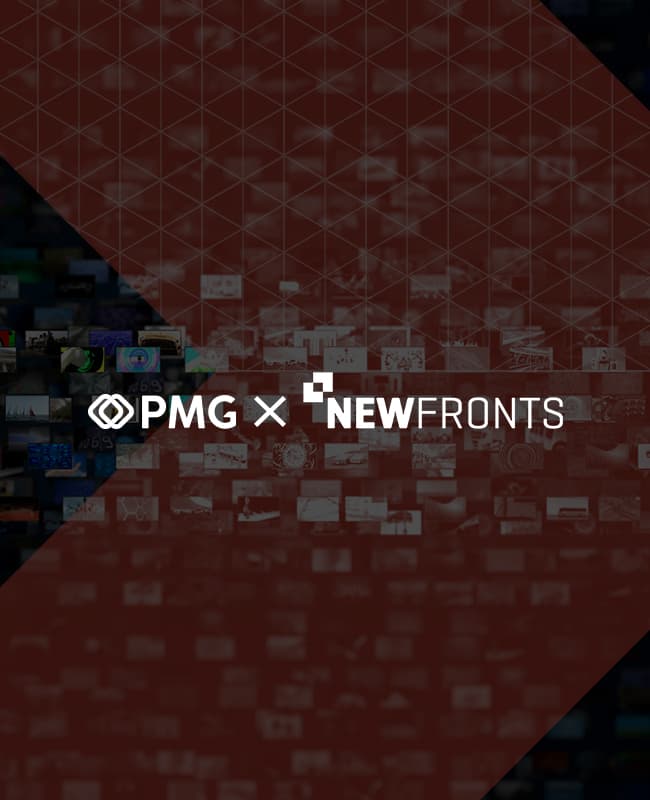Accessibility Tools
PMG Digital Made for Humans
Takeaways from the 2025 IAB NewFronts
4 MINUTE READ | May 14, 2025

Takeaways from the 2025 IAB NewFronts
Natalee Geldert, Head of Emerging Services
Natalee Geldert is the Head of Emerging Services at PMG, focusing on strategy development and executional excellence across a portfolio of top clients. She has over fifteen years of experience developing large-scale campaigns aimed at driving awareness and establishing a notable market position for global brands. Natalee also engages in regular business and strategy conversations to ensure proper ideation and how we are driving our clients’ businesses forward. Natalee graduated from Southern Methodist University with a BA in Creative Advertising, Fine Art and Art History, later studying International Advertising at Regent’s University London.
The 2025 NewFronts showcased a media landscape defined less by channel and more by outcome, authenticity, and intelligence. Attention is becoming a transactional metric, not just diagnostic. AI is deeply embedded across planning, creative, and measurement. Retail media is now infrastructure, not a silo. And cultural fluency has become a foundational requirement for brand relevance.
CTV Matures, Attention Becomes Currency: Emotion and context are rising targeting currencies as seen in Wurl and Tubi’s AI-driven ad alignment. Platforms like Teads, Wurl, Amazon, and LG are elevating CTV from a top-funnel channel to a full-funnel, performance-oriented platform. Attention is now being positioned as a measurable currency, going beyond viewability to tie directly to brand outcomes. Creative innovation in CTV is accelerating, unlocking mid- and lower-funnel performance through formats like gamified ads, pause ads, and social-to-CTV integrations.
Retail Media’s Evolution & AI Embedded Everywhere: Retail Media Networks (RMNs) are expanding into DSPs and streaming environments, with Google and Amazon layering commerce data into platforms like DV360. At the same time, AI is being used for everything from contextual ad placement (Wurl, Tubi) to automated media buying and campaign generation (Meta, Google, YouTube). Real-time adaptability is also becoming a norm, with platforms like Amazon and ReachTV enabling mid-campaign optimization.
Cultural Fluency Is Now a Media Imperative: Publishers like A+E, Revry, Estrella, MyCode, and LatiNation are proving that culturally fluent, identity-driven storytelling isn’t a niche strategy—it’s central to audience engagement and brand growth. These platforms are offering advertisers authentic connections with diverse and high-value communities. This signals mounting pressure on the industry to move beyond legacy metrics and lean into relevance and representation as performance drivers.
Social Is Searchable, Shoppable, & AI-Powered: Social platforms are becoming intent engines. TikTok, YouTube, and Meta are leaning into search behaviors and creator-driven discovery. New tools like TikTok’s Symphony and Meta’s Advantage+ use generative AI to scale content creation, targeting, and shopping integrations. Creators are evolving into strategic media channels as platforms offer better discovery tools, performance insights, and activation paths.
CTV Evolves Into a Full-Funnel, Measurable Medium: Creative innovation in CTV is unlocking new mid- and lower-funnel opportunities, including pause ads, gamified formats, and social-to-CTV integrations. CTV is no longer just about reach and awareness. Amazon’s Brand+ and Complete TV offerings, Teads’ attention-based buying, and LG’s shoppable and interactive formats signal a new focus on driving mid- and lower-funnel impact. Early results from Teads reported a 48% sales lift and a 40% increase in store visits in emotionally aligned campaigns.
AI & Automation Are Reshaping Every Layer of Advertising: Real-time adaptability is now table stakes, with platforms like Amazon and ReachTV enabling optimization mid-campaign. AI is reshaping the ad stack from planning to execution. Google’s DV360 uses generative AI for media plan recommendations and campaign setup, while platforms like Meta and Snap are embedding AI to automate budgeting, creative optimization, and targeting. At this year’s Newfronts, Wurl and Tubi showed how they use AI to match ad content to genre, tone, and emotional context in real time.
Retail Media Is Expanding Beyond Retail: The convergence of commerce and media continues. Nielsen reports 74% of advertisers plan to use RMNs this year, up from 63%. To take advantage of this growing interest, Amazon and Google are integrating RMN data into DSPs and YouTube, bringing commerce insights to broader media activations. Retail media is quickly becoming a foundational layer in cross-channel strategies, though its growth varies by platform maturity and advertiser readiness.
Identity, Inclusion & Culture Drive Differentiation: Measurement pressure is mounting, with more emphasis on attention, dwell time, and predictive ROI models as better proxies than impressions or viewability. Cultural alignment was a standout theme across many sessions at Newfronts this year. MyCode, Revry, Estrella, and LatiNation emphasized identity as strategy, with content designed to reflect, not just represent, their audiences. A+E and the New York Times reinforced that inclusive, curiosity-driven storytelling builds trust and drives measurable attention.
Search & Discovery Are the New Social Battleground: Social platforms like TikTok and YouTube are no longer just for passive entertainment—they’ve become search engines and discovery tools, especially for Gen Z. This shift requires brands to think beyond interruption and lean into intent capture with keyword-optimized creative. Platforms are adapting fast: Meta’s Trends in Creator Marketplace and YouTube’s Insights Finder are helping brands align with trending content, while creators are evolving into performance partners. As Gen Z increasingly uses platforms like TikTok and YouTube as search engines, the value of discovery-based planning is rising. Creative now needs to be keyword-optimized and behaviorally aligned. Meta’s tools, like Trends in Creator Marketplace and YouTube’s Insights Finder, give advertisers ways to act on this shift in real time.
Media in 2025 is immersive, intelligent, and identity-driven: The most effective partners are no longer just selling inventory—they’re building ecosystems that merge AI, creators, commerce, and culture to drive outcomes. For brands, success will depend on embracing emotional relevance, predictive targeting, and a deeper, more authentic connection with audiences across every screen. Those who act now will define the next chapter of intelligent, performance-driven media.
Stay in touch
Bringing news to you
Subscribe to our newsletter
By clicking and subscribing, you agree to our Terms of Service and Privacy Policy












